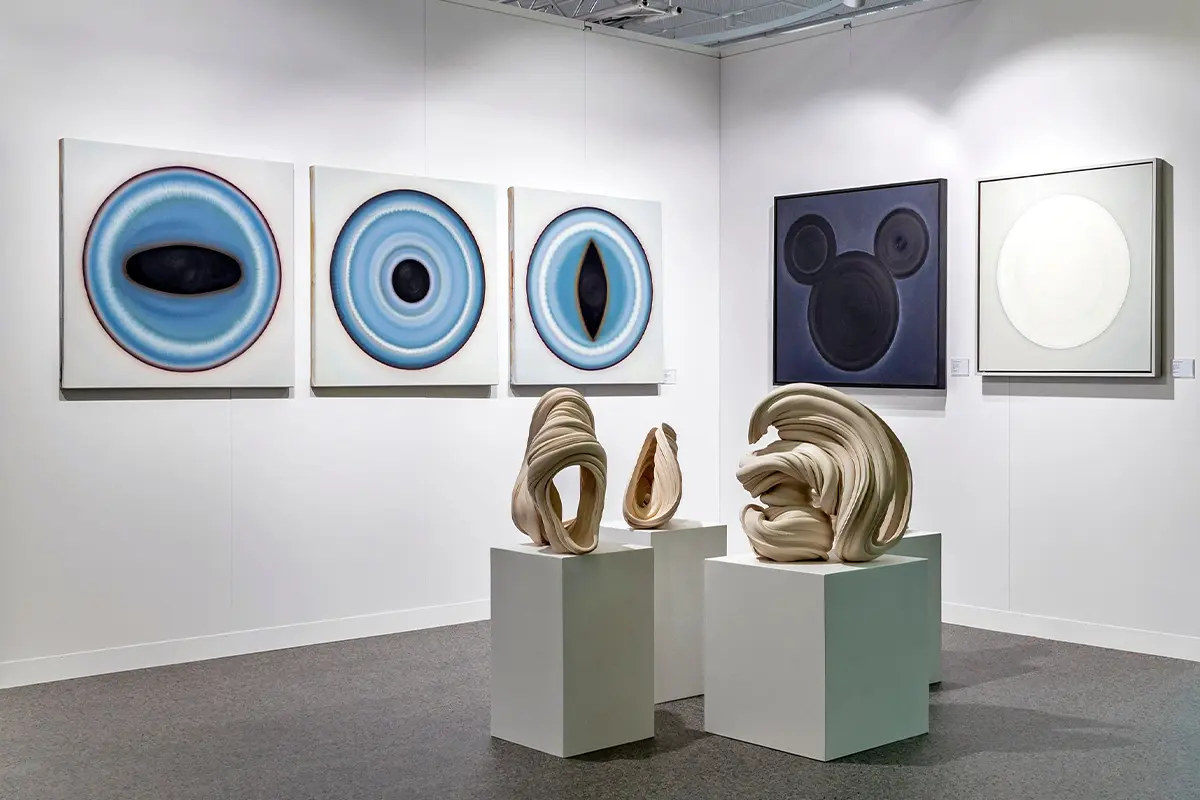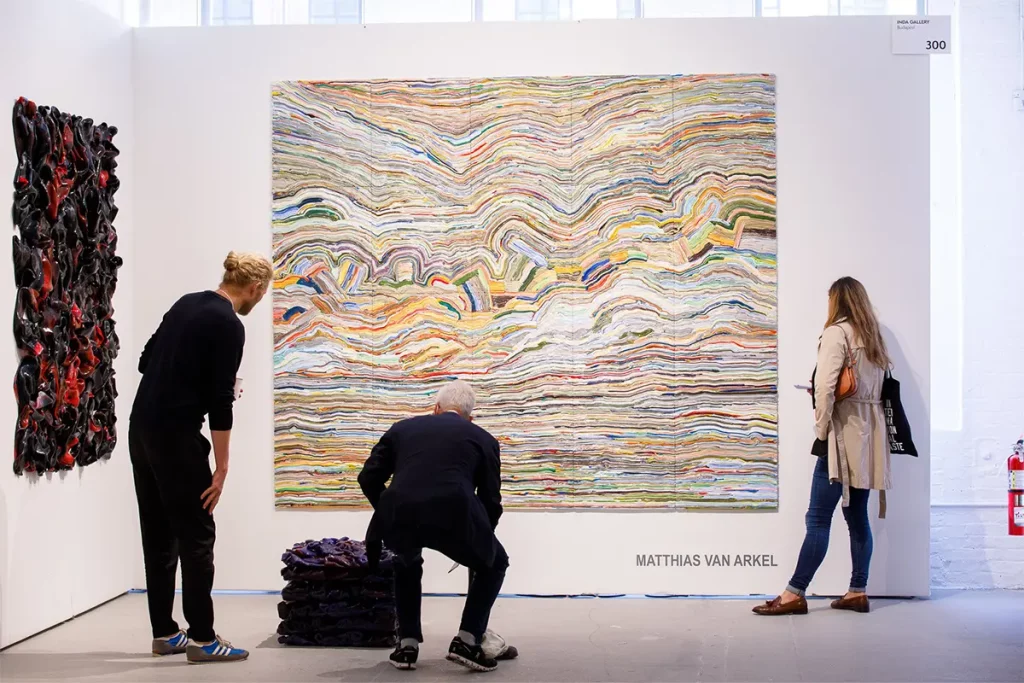In Italian, VOLTA means to turn, to shift. «We chose this word because that’s what we’re trying to do for our artists, gallerists, and collectors. Our tagline is ‘discover, connect and collect’»
‘Discover, connect and collect’ at VOLTA Art Fair
VOLTA is a contemporary art fair created in 2005. It began in Basel as a collaboration between art dealers and their network of friends. Following the fair’s success in Basel, VOLTA was exported to New York in 2008.
According to VOLTA Basel’s current co-director, Cristina Salmastrelli, the name of this contemporary art fair sums up its concept. In Italian, VOLTA means to turn, to shift. In a sonnet, a VOLTA is a rhetorical shift or turn of thought. «We chose this word because that’s what we’re trying to do for our artists, gallerists, and collectors. Our tagline is ‘discover, connect and collect’. That’s the idea; we are a place for discovery».
Whether it’s a gallery or an artist, VOLTA aims to help the viewer and the collector focus on this shift.
The exhibition concept of this contemporary art fair is to offer as much focus as possible on the presentation. According to their intention, the visitor’s eye should be able to concentrate on each element exhibited during the event.
Despite VOLTA’s evolution over the years, the core has remained the same: the artist must be at the center. The galleries’ dedication to their artists must be palpable.
«You’re never going to see someone more obsessed with an artist than their gallerist. To be able to put that emotion on view allows the collector or the viewer to get deeper emotionally. I always enjoy seeing people take a moment or sit. The artist, gallerist and public are connected during the exhibition. It’s always after this emotional connection that the effect works on the viewers» Salmastrelli explains.
The selection criteria at VOLTA Basel: pushing boundaries
According to Cristina Salmastrelli, VOLTA carries out a selection process of the artists and galleries they wish to exhibit at their fair. The first element in this selection is the relationship between the artist and their gallerist, and vice versa. She explains that the two must complement each other. The gallerist must enable the artist to grow and evolve in their artistic work. As for the artist, they must produce work that invites the public to reflect. Having direct contact with the artist is also an essential element for VOLTA. Artists who take risks and push the boundaries are always of interest.
«When we look at somebody’s body of work, we ask ourselves if this artist has a deep creative spirit. Is there an evolution in their work? Are we seeing the body of work evolving? Of course, we also analyze the market trends, and we assess what’s going on in the world. We want to make sure that we’re following the evolution of our galleries as well. We don’t want the gallerist to keep bringing back the same things. That’s not going to help anyone improve and evolve the contemporary art world».
The city of Basel as the center for the contemporary art scene
VOLTA’s co-director explains why the contemporary art world rotates around the city of Basel. According to Salmastrelli, the city has always had a history with this type of art. It’s where artists have seen their careers take off, where they’ve been able to perfect their stories and their work. The same goes for the galleries. Over the decades, Basel has carved out a place for itself among the international hubs of contemporary art, thanks to its artists and their quality of expression.
That’s when we start to wonder about the difference between the Basel and New York art scenes. Cristina Salmastrelli explains that the difference begins with viewership.
«How viewers absorb the art in these two cities is different. Our mission of presenting art to the public is too. In New York, for example, solo events are more attractive whereas the Basel audience appears to prefer tours. They prefer communication through an expert. I think it’s all about how they absorb the knowledge». she adds.
About VOLTA Basel, the 2023 edition
This year’s edition will mark a turning point in the history of VOLTA Basel. In addition to the artists present, the contemporary art fair will be presented in a new venue. The venue in question is a former canteen on the Novartis campus in Basel’s Klybeck district. The building was constructed in 1967 by Suter + Suter.
«The venue feels like a cloud. In order to see the artwork, you have to climb some stairs. It feels like you’re above everything. And you’re in this kind of box. This package is able to enhance the artists’ work. And, to make it more valuable, we took the decision to limit the space to thirty galleries from sixteen countries».
According to Cristina Salmastrelli, the artists choice was not an easy one for them, as last year alone the fair brought together seventy international galleries. Because of the large number of art events offered by the city of Basel, VOLTA wishes to keep to its own niche by reducing the number of participants.
«I think we’re organizing the edition with the greatest diversity of nationalities in relation to the number of exhibitors this year. In creating this diversity, we also want to show a full market view of what the contemporary art market looks like in terms of evolution. We want to attract as many storylines as possible».
The conflicts between art and science, nature and man. The themes at VOLTA, 2023 edition
Cristina Salmastrelli explains that every year a different theme is tackled.
«We are seeing a lot of tension between art and science right now. In this tension between art and science there is always going to be this nature versus man subject. This year we will see a lot of wrestling between unconscious notions of what success is, of what is hurting or helping Mother Earth».
Salmastrelli uses the example of artist Irene Grau, exhibited this year at VOLTA Basel, to illustrate her point.
«Irene Grau created a project based on her performative walk through the Swiss Alps. This performance brings out Man versus Nature. The questions this walk raised in the minds of the artist and the public: how to connect and stand out? How can we live in harmony together?» .
The effect of the lockdown over visitor and arts production according to Cristina Salmastrelli
During the pandemic, the art world was faced with this existential question concerning its relationship with the environment. And according to Cristina Salmastrelli, this question is necessary.
«We couldn’t travel during the pandemic. People became much more regional. I think the issue of creating a tension between art and our planet preservation led to a more regionalized view of the art fairs. I feel like we’re slowly coming back to a slower rhythm. Regional art fairs come to a more significant part in the global art market. There were many silver linings that came out of being regionalized. The art market will survive only if it becomes slightly more local».
Salmastrelli believes that with the shutdown of travel and the economy during the lockdown, creativity exploded in most artists. In her words, she saw a certain intensity in the artworks that came out of this pandemic period.
«There’s this artist that comes to mind when I think about this creative boom during the pandemic. Her name is Galina Kurlat and she is a portrait photographer. She was represented by 3 galleries in New York just a few weeks ago. She wanted to show herself without herself. During the pandemic she started experimenting with her bath water, her blood, her hair, and her breast milk in a series of very personal photographs. Her work is moving because you don’t see her in the photos. Despite this, you get to see all of her. You see her entire DNA».
The relationship between arts and nature: the commitment of VOLTA and contemporary art fairs
Cristina Salmastrelli claims that the world is at a tipping point regarding the relationship between Nature and Art. She believes that either we ignore this tipping point and continue to exploit our planet, or we choose to change our ways. In her opinion, the change will come through the artists that the galleries choose to show.
«I’m waiting to see how things progress in the second half of this year and into 2024. Personally, I think things are changing for the better, especially in terms of contemporary art fairs. We’re seeing more and more galleries and artists who are politically and ecologically committed. I think that within a year we’ll know which way to go. Either we go back to the globalization of contemporary art, or we focus on the regionalization of art fairs».
VOLTA, Basel
Founded in 2005, VOLTA Basel is an annual international contemporary art fair based in Basel, Switzerland and New York City, United States. The 2023 edition of the fair takes place between June 12 and June 18, 2023, in the new venue at Klybeck 610, Klybeckplatz, Gärtnerstrasse 2, 4057 Basel, Switzerland.




















